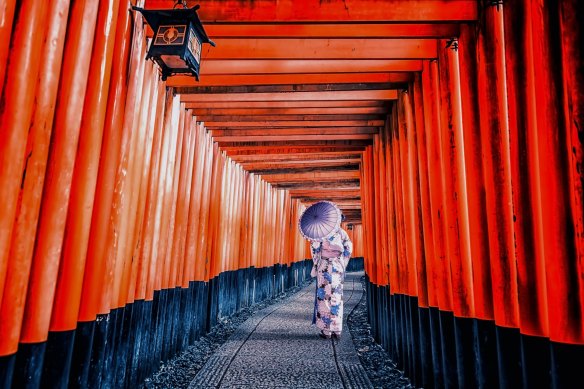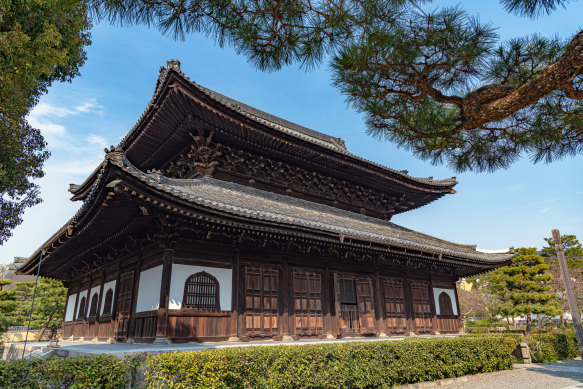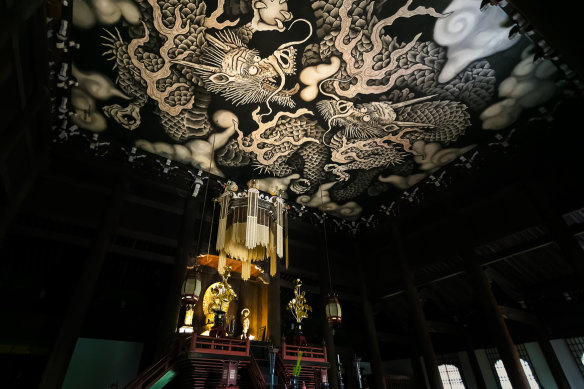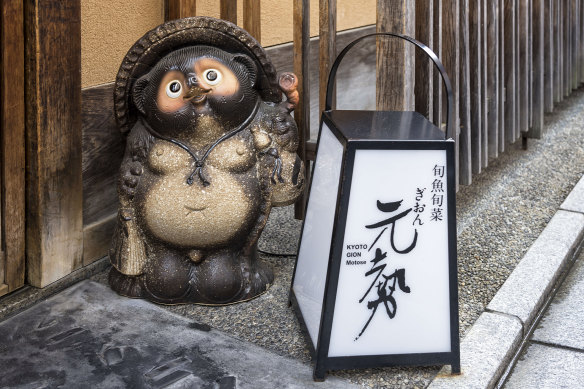The only (ballsy) temples you need to see in Japan’s culture capital
By Keith Austin
Kyoto, says Richard Farmer, our guide, is the culture capital of Japan. I am reminded of this later when I’m forced to ask him “what’s the go with the huge gonads on these statues?”
Farmer, British-born but a long-term resident of Japan who speaks the language fluently, breaks out in an infectious grin: “They’re called tanuki and …”
But I’m getting ahead of myself.
Kyoto is pretty much synonymous with geishas, traditional wooden townhouses, and temples, lots and lots of them (1600 at the last count). It is a city, confesses Farmer, where it is very easy to get “templed out”.

Vist Fushimi Inari early to avoid the thick of the crowds.Credit: iStock
In the end, we visit three of them, including Fushimi Inari, famous for the thousand scarlet-red gates (torii) that snake up the side of Mount Inari. For the first-time visitor to Kyoto, Fushimi Inari is a must-see, but my advice would be to go very early (entry is free and it’s open 24 hours, 365 days a year) because during the day it’s an overcrowded nightmare, a victim of its own beauty.
Tick it off your list and then take the time to visit Kennin-ji and Tanukidani Fudoin temples – or as I remember them, the dragon and the scrotum temples respectively.
Kennin-ji is a Zen Buddhist temple in the Higashiyama district. Founded in 1202 it did what many of the temples in Japan have done over the years and burnt down. Several times. The current Johnny-come-lately buildings date from the 16th and 18th centuries.
Apart from a funny sign warning visitors there is no lying down in the temple, it’s the artworks that catch the eye. Wind God and Thunder God, by artist Tawaraya Sotatsu, is a set of folding screens depicting the aforesaid demon-headed celestials using ink and colour on gold-foil paper. Painted in the 17th century Edo Period it has quite rightly been designated a National Treasure of Japan.

Kennin-ji was founded in 1202.Credit: iStock
Nearby is another, more recent artwork; a piece of calligraphy from 2006 by Shoko Kanazawa, one of Japan’s most famous calligraphers. The scroll, which depicts the Chinese characters for Wind God and Thunder God, is a broiling, visceral rendering of the original work – all the more impressive when you learn that 38-year-old Kanazawa has Down Syndrome.
The best is saved until last when we enter the main hall and look up. On the ceiling is a massive (11.4 metre by 15.7 metre) black-and-white artwork of two dragons by artist Junsaku Koizumi. Bold and dramatic, it was installed in 2002 to celebrate the temple’s 800th anniversary.

The Twin Dragons painting on the ceiling of the main hall of Kennin-ji.Credit: iStock
Tanukidani Fudoin is a quietly remote Buddhist temple at the top of a ravine about a 30-minute taxi ride from the city centre. There are fewer torii here, and it’s a steep climb up the steps to the temple, but it’s mercifully free of the crowds that plague Fushimi Inari.
It’s here, on the bosky path up to the temple itself, that we encounter dozens of little ceramic figures with the oversized but quite cute scrota (not a sentence I ever thought I’d find myself writing).

A lucky tanuki statue pictured outside a Kyoto restaurant.Credit: iStock
The tanuki is in real life a small mammal that looks like the result of a particularly debauched night out by a raccoon and a dissolute badger. It does NOT have huge genitalia. The historical reasons for the enlarged scrotum on the statues are long and tortured and involve gold leaf, a Japanese language double entendre and a large dollop of myth. Suffice to say, they are said to be lucky*.
*Disclaimer: Traveller is not a health practitioner and as far as we know an enlarged scrotum isn’t always lucky. If you look like a tanuki statue, please seek medical advice.
THE DETAILS
Tour
InsideJapan Tours offers small group tours, tailored self-guided adventures and cultural experiences in Japan. Hotels are chosen based on the individual traveller’s needs and budget. See insidejapantours.com or call (07) 3186-8800.
Fly
Cathay Pacific flies daily from Sydney and Melbourne to Osaka, via Hong Kong. See cathaypacific.com/au for times and prices. Osaka is the closest airport to Kyoto.
Train
The fastest way to get to Kyoto from Osaka is by the Shinkansen bullet train. The journey takes about 15 minutes. Special Rapid trains also run between the two but take about 25 minutes. If you’re going to travel by train a lot it’s worth getting the JR Pass (valid for 7, 14 and 21 days). For details and prices see jrailpass.com
The writer was a guest of InsideJapan Tours and Cathay Pacific.
Sign up for the Traveller Deals newsletter
Get exclusive travel deals delivered straight to your inbox. Sign up now.